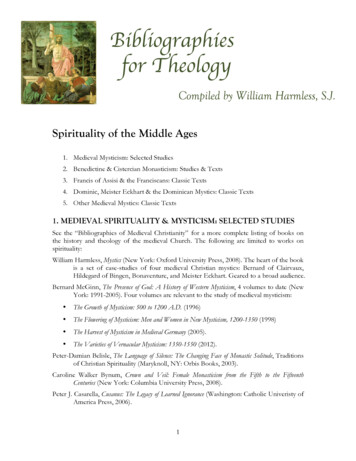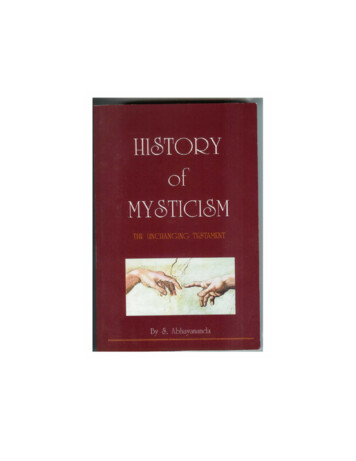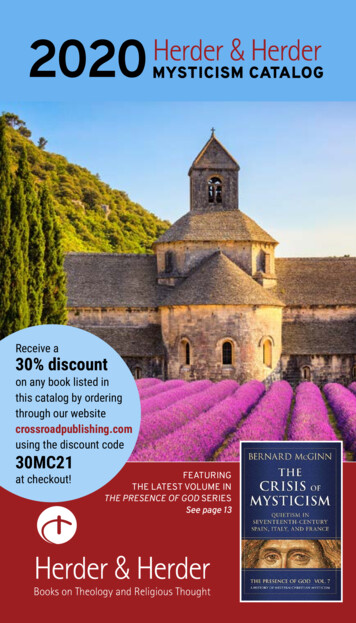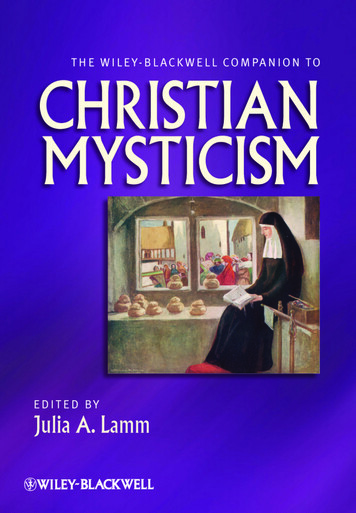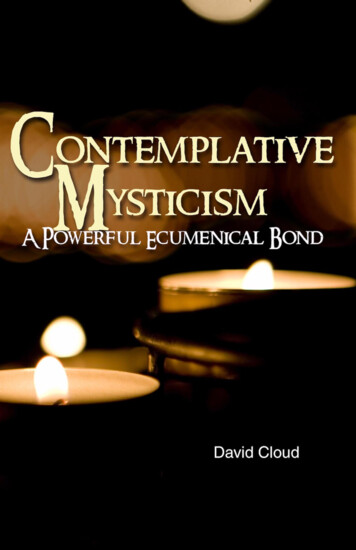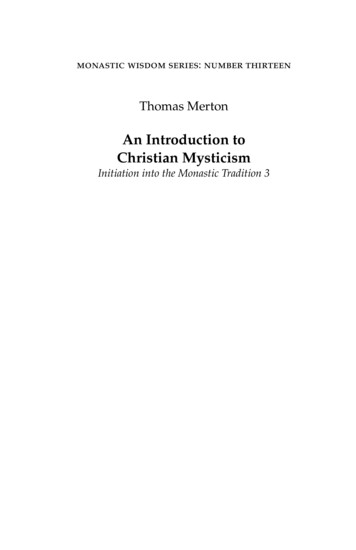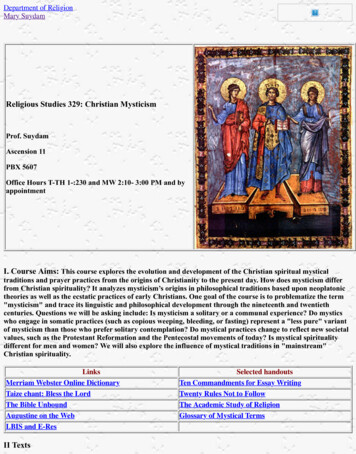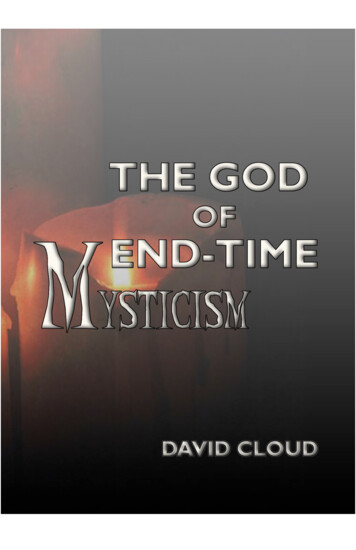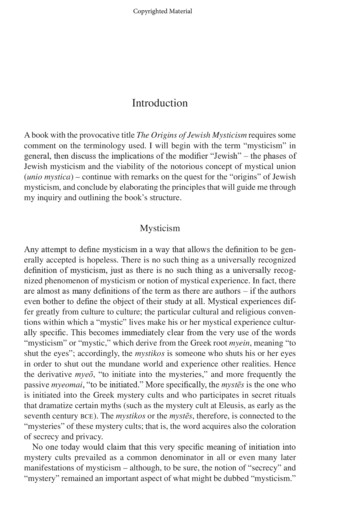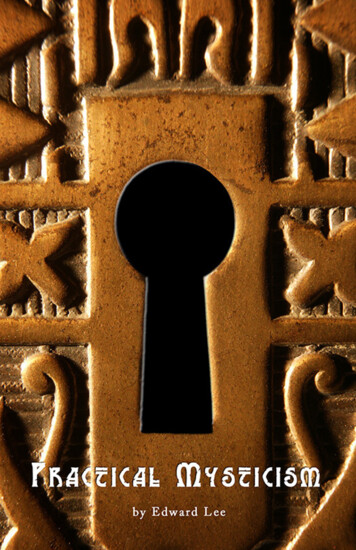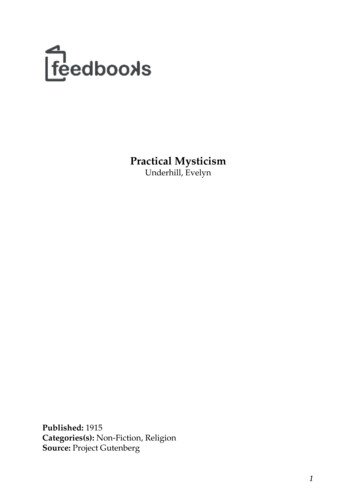
Transcription
Practical MysticismUnderhill, EvelynPublished: 1915Categories(s): Non-Fiction, ReligionSource: Project Gutenberg1
About Underhill:Evelyn Underhill was an English Anglo-Catholic writer and pacifistknown for her numerous works on religion and spiritual practice, in particular Christian mysticism. In the English-speaking world, she was oneof the most widely read writers on such matters in the first half of thetwentieth century. No other book of its type — until the appearance in1946 of Aldous Huxley's The Perennial Philosophy — met with successto match that of her best-known work, Mysticism, published in 1911.(Source: Wikipedia)Copyright: This work is available for countries where copyright isLife 50 or in the USA (published before 1923).Note: This book is brought to you by Feedbooks.http://www.feedbooks.comStrictly for personal use, do not use this file for commercial purposes.2
PrefaceThis little book, written during the last months of peace, goes to press inthe first weeks of the great war. Many will feel that in such a time of conflict and horror, when only the most ignorant, disloyal, or apathetic canhope for quietness of mind, a book which deals with that which is calledthe "contemplative" attitude to existence is wholly out of place. So obvious, indeed, is this point of view, that I had at first thought of postponing its publication. On the one hand, it seems as though the dreams of aspiritual renaissance, which promised so fairly but a little time ago, hadperished in the sudden explosion of brute force. On the other hand, thethoughts of the English race are now turned, and rightly, towards themost concrete forms of action—struggle and endurance, practical sacrifices, difficult and long-continued effort—rather than towards the passive attitude of self-surrender which is all that the practice of mysticismseems, at first sight, to demand. Moreover, that deep conviction of thedependence of all human worth upon eternal values, the immanence ofthe Divine Spirit within the human soul, which lies at the root of a mystical concept of life, is hard indeed to reconcile with much of the humanhistory now being poured red-hot from the cauldron of war. For all thesereasons, we are likely during the present crisis to witness a revolt fromthose superficially mystical notions which threatened to become too popular during the immediate past.Yet, the title deliberately chosen for this book—that of "Practical" Mysticism—means nothing if the attitude and the discipline which it recommends be adapted to fair weather alone: if the principles for which itstands break down when subjected to the pressure of events, and cannotbe reconciled with the sterner duties of the national life. To accept thisposition is to reduce mysticism to the status of a spiritual plaything. Onthe contrary, if the experiences on which it is based have indeed the transcendent value for humanity which the mystics claim for them—if theyreveal to us a world of higher truth and greater reality than the world ofconcrete happenings in which we seem to be immersed—then that valueis increased rather than lessened when confronted by the overwhelmingdisharmonies and sufferings of the present time. It is significant thatmany of these experiences are reported to us from periods of war anddistress: that the stronger the forces of destruction appeared, the moreintense grew the spiritual vision which opposed them. We learn fromthese records that the mystical consciousness has the power of liftingthose who possess it to a plane of reality which no struggle, no cruelty,3
can disturb: of conferring a certitude which no catastrophe can wreck.Yet it does not wrap its initiates in a selfish and otherworldly calm, isolate them from the pain and effort of the common life. Rather, it givesthem renewed vitality; administering to the human spirit not—as somesuppose—a soothing draught, but the most powerful of stimulants.Stayed upon eternal realities, that spirit will be far better able to endureand profit by the stern discipline which the race is now called to undergo, than those who are wholly at the mercy of events; better able to discern the real from the illusory issues, and to pronounce judgment on thenew problems, new difficulties, new fields of activity now disclosed. Perhaps it is worth while to remind ourselves that the two women whohave left the deepest mark upon the military history of France and England—Joan of Arc and Florence Nightingale—both acted under mysticalcompulsion. So, too, did one of the noblest of modern soldiers, GeneralGordon. Their national value was directly connected with their deepspiritual consciousness: their intensely practical energies were theflowers of a contemplative life.We are often told, that in the critical periods of history it is the nationalsoul which counts: that "where there is no vision, the people perish." Nonation is truly defeated which retains its spiritual self-possession. No nation is truly victorious which does not emerge with soul unstained. Ifthis be so, it becomes a part of true patriotism to keep the spiritual life,both of the individual citizen and of the social group, active and vigorous; its vision of realities unsullied by the entangled interests and passions of the time. This is a task in which all may do their part. The spiritual life is not a special career, involving abstraction from the world ofthings. It is a part of every man's life; and until he has realised it he is nota complete human being, has not entered into possession of all hispowers. It is therefore the function of a practical mysticism to increase,not diminish, the total efficiency, the wisdom and steadfastness, of thosewho try to practise it. It will help them to enter, more completely thanever before, into the life of the group to which they belong. It will teachthem to see the world in a truer proportion, discerning eternal beautybeyond and beneath apparent ruthlessness. It will educate them in acharity free from all taint of sentimentalism; it will confer on them an unconquerable hope; and assure them that still, even in the hour of greatestdesolation, "There lives the dearest freshness deep down things." As acontribution, then, to these purposes, this little book is now published. Itis addressed neither to the learned nor to the devout, who are already inpossession of a wide literature dealing from many points of view with4
the experiences and philosophy of the mystics. Such readers are warnedthat they will find here nothing but the re-statement of elementary andfamiliar propositions, and invitations to a discipline immemorially old.Far from presuming to instruct those to whom first-hand information isboth accessible and palatable, I write only for the larger class which, repelled by the formidable appearance of more elaborate works on the subject, would yet like to know what is meant by mysticism, and what it hasto offer to the average man: how it helps to solve his problems, how itharmonises with the duties and ideals of his active life. For this reason, Ipresuppose in my readers no knowledge whatever of the subject, eitherupon the philosophic, religious, or historical side. Nor, since I wish myappeal to be general, do I urge the special claim of any one theologicalsystem, any one metaphysical school. I have merely attempted to put theview of the universe and man's place in it which is common to all mystics in plain and untechnical language: and to suggest the practical conditions under which ordinary persons may participate in their experience. Therefore the abnormal states of consciousness which sometimesappear in connection with mystical genius are not discussed: my business being confined to the description of a faculty which all men possessin a greater or less degree.The reality and importance of this faculty are considered in the firstthree chapters. In the fourth and fifth is described the preliminary training of attention necessary for its use; in the sixth, the general self-discipline and attitude toward life which it involves. The seventh, eighth, andninth chapters treat in an elementary way of the three great forms of contemplation; and in the tenth, the practical value of the life in which theyhave been actualised is examined. Those kind enough to attempt the perusal of the book are begged to read the first sections with some attentionbefore passing to the latter part.E. U.September 12, 1914.5
Chapter1What is Mysticism?Those who are interested in that special attitude towards the universewhich is now loosely called "mystical," find themselves beset by a multitude of persons who are constantly asking—some with real fervour,some with curiosity, and some with disdain—"What is mysticism?"When referred to the writings of the mystics themselves, and to otherworks in which this question appears to be answered, these people replythat such books are wholly incomprehensible to them.On the other hand, the genuine inquirer will find before long a number of self-appointed apostles who are eager to answer his question inmany strange and inconsistent ways, calculated to increase rather thanresolve the obscurity of his mind. He will learn that mysticism is a philosophy, an illusion, a kind of religion, a disease; that it means having visions, performing conjuring tricks, leading an idle, dreamy, and selfishlife, neglecting one's business, wallowing in vague spiritual emotions,and being "in tune with the infinite." He will discover that it emancipateshim from all dogmas—sometimes from all morality—and at the sametime that it is very superstitious. One expert tells him that it is simply"Catholic piety," another that Walt Whitman was a typical mystic; a thirdassures him that all mysticism comes from the East, and supports hisstatement by an appeal to the mango trick. At the end of a prolongedcourse of lectures, sermons, tea-parties, and talks with earnest persons,the inquirer is still heard saying—too often in tones of exasperation—"What is mysticism?"I dare not pretend to solve a problem which has provided so muchgood hunting in the past. It is indeed the object of this little essay to persuade the practical man to the one satisfactory course: that of discoveringthe answer for himself. Yet perhaps it will give confidence if I confesspears to cover all the ground; or at least, all that part of the groundwhich is worth covering. It will hardly stretch to the mango trick; but it6
finds room at once for the visionaries and the philosophers, for WaltWhitman and the saints.Here is the definition:—Mysticism is the art of union with Reality. The mystic is a person who has attained that union in greater or less degree; or who aims at and believes in suchattainment.It is not expected that the inquirer will find great comfort in this sentence when first it meets his eye. The ultimate question, "What is Reality?"—a question, perhaps, which never occurred to him before—isalready forming in his mind; and he knows that it will cause himinfinite-distress. Only a mystic can answer it: and he, in terms which other mystics alone will understand. Therefore, for the time being, the practical man may put it on one side. All that he is asked to consider now isthis: that the word "union" represents not so much a rare and unimaginable operation, as something which he is doing, in a vague, imperfectfashion, at every moment of his conscious life; and doing with intensityand thoroughness in all the more valid moments of that life. We know athing only by uniting with it; by assimilating it; by an interpenetration ofit and ourselves. It gives itself to us, just in so far as we give ourselves toit; and it is because our outflow towards things is usually so perfunctoryand so languid, that our comprehension of things is so perfunctory andlanguid too. The great Sufi who said that "Pilgrimage to the place of thewise, is to escape the flame of separation" spoke the literal truth. Wisdomis the fruit of communion; ignorance the inevitable portion of those who"keep themselves to themselves," and stand apart, judging, analysing thethings which they have never truly known.Because he has surrendered himself to it, "united" with it, the patriotknows his country, the artist knows the subject of his art, the lover hisbeloved, the saint his God, in a manner which is inconceivable as well asunattainable by the looker-on. Real knowledge, since it always impliesan intuitive sympathy more or less intense, is far more accurately suggested by the symbols of touch and taste than by those of hearing andsight. True, analytic thought follows swiftly upon the contact, the apprehension, the union: and we, in our muddle-headed way, have persuadedourselves that this is the essential part of knowledge—that it is, in fact,more important to cook the hare than to catch it. But when we get rid ofthis illusion and go back to the more primitive activities through whichour mental kitchen gets its supplies, we see that the distinction betweenmystic and non-mystic is not merely that between the rationalist and thedreamer, between intellect and intuition. The question which divides7
them is really this: What, out of the mass of material offered to it, shallconsciousness seize upon—with what aspects of the universe shall it"unite"?It is notorious that the operations of the average human consciousnessunite the self, not with things as they really are, but with images, notions,aspects of things. The verb "to be," which he uses so lightly, does nottruly apply to any of the objects amongst which the practical man supposes himself to dwell. For him the hare of Reality is always readyjugged: he conceives not the living lovely, wild, swift-moving creaturewhich has been sacrificed in order that he may be fed on the deplorabledish which he calls "things as they really are." So complete, indeed, is theseparation of his consciousness from the facts of being, that he feels nosense of loss. He is happy enough "understanding," garnishing, assimilating the carcass from which the principle of life and growth has beenejected, and whereof only the most digestible portions have been retained. He is not "mystical."But sometimes it is suggested to him that his knowledge is not quite sothorough as he supposed. Philosophers in particular have a way ofpointing out its clumsy and superficial character; of demonstrating thefact that he habitually mistakes his own private sensations for qualitiesinherent in the mysterious objects of the external world. From those fewqualities of colour, size, texture, and the rest, which his mind has beenable to register and classify, he makes a label which registers the sum ofhis own experiences. This he knows, with this he "unites"; for it is hisown creature. It is neat, flat, unchanging, with edges well defined: athing one can trust. He forgets the existence of other conscious creatures,provided with their own standards of reality. Yet the sea as the fish feelsit, the borage as the bee sees it, the intricate sounds of the hedgerow asheard by the rabbit, the impact of light on the eager face of the primrose,the landscape as known in its vastness to the wood-louse and ant—allthese experiences, denied to him for ever, have just as much claim to theattribute of Being as his own partial and subjective interpretations ofthings.Because mystery is horrible to us, we have agreed for the most part tolive in a world of labels; to make of them the current coin of experience,and ignore their merely symbolic character, the infinite gradation of values which they misrepresent. We simply do not attempt to unite withReality. But now and then that symbolic character is suddenly broughthome to us. Some great emotion, some devastating visitation of beauty,love, or pain, lifts us to another level of consciousness; and we are aware8
for a moment of the difference between the neat collection of discrete objects and experiences which we call the world, and the height, the depth,the breadth of that living, growing, changing Fact, of which thought, life,and energy are parts, and in which we "live and move and have our being." Then we realise that our whole life is enmeshed in great and livingforces; terrible because unknown. Even the power which lurks in everycoal-scuttle, shines in the electric lamp, pants in the motor-omnibus, declares itself in the ineffable wonders of reproduction and growth, is supersensual. We do but perceive its results. The more sacred plane of lifeand energy which seems to be manifested in the forces we call "spiritual"and "emotional"—in love, anguish, ecstasy, adoration—is hidden fromus too. Symptoms, appearances, are all that our intellects can discern:sudden irresistible inroads from it, all that our hearts can apprehend.The material for an intenser life, a wider, sharper consciousness, a moreprofound understanding of our own existence, lies at our gates. But weare separated from it, we cannot assimilate it; except in abnormal moments, we hardly know that it is. We now begin to attach at least a fragmentary meaning to the statement that "mysticism is the art of unionwith Reality." We see that the claim of such a poet as Whitman to be amystic lies in the fact that he has achieved a passionate communion withdeeper levels of life than those with which we usually deal—has thrustpast the current notion to the Fact: that the claim of such a saint as Teresais bound up with her declaration that she has achieved union with theDivine Essence itself. The visionary is a mystic when his vision mediatesto him an actuality beyond the reach of the senses. The philosopher is amystic when he passes beyond thought to the pure apprehension oftruth. The active man is a mystic when he knows his actions to be a partof a greater activity. Blake, Plotinus, Joan of Arc, and John of theCross—there is a link which binds all these together: but if he is to makeuse of it, the inquirer must find that link for himself. All four exhibit different forms of the working of the contemplative consciousness; a facultywhich is proper to all men, though few take the trouble to develop it.Their attention to life has changed its character, sharpened its focus: andas a result they see, some a wider landscape, some a more brilliant, moresignificant, more detailed world than that which is apparent to the lesseducated, less observant vision of common sense. The old story of Eyesand No-Eyes is really the story of the mystical and unmystical types."No-Eyes" has fixed his attention on the fact that he is obliged to take awalk. For him the chief factor of existence is his own movement alongthe road; a movement which he intends to accomplish as efficiently and9
comfortably as he can. He asks not to know what may be on either sideof the hedges. He ignores the caress of the wind until it threatens to remove his hat. He trudges along, steadily, diligently; avoiding the muddypools, but oblivious of the light which they reflect. "Eyes" takes the walktoo: and for him it is a perpetual revelation of beauty and wonder. Thesunlight inebriates him, the winds delight him, the very effort of thejourney is a joy. Magic presences throng the roadside, or cry salutationsto him from the hidden fields. The rich world through which he moveslies in the fore-ground of his consciousness; and it gives up new secretsto him at every step. "No-Eyes," when told of his adventures, usually refuses to believe that both have gone by the same road. He fancies that hiscompanion has been floating about in the air, or beset by agreeable hallucinations. We shall never persuade him to the contrary unless we persuade him to look for himself.Therefore it is to a practical mysticism that the practical man is here invited: to a training of his latent faculties, a bracing and brightening of hislanguid consciousness, an emancipation from the fetters of appearance, aturning of his attention to new levels of the world. Thus he may becomeaware of the universe which the spiritual artist is always trying to disclose to the race. This amount of mystical perception—this "ordinarycontemplation," as the specialists call it—is possible to all men: withoutit, they are not wholly conscious, nor wholly alive. It is a natural humanactivity, no more involving the great powers and sublime experiences ofthe mystical saints and philosophers than the ordinary enjoyment of music involves the special creative powers of the great musician.As the beautiful does not exist for the artist and poet alone—thoughthese can find in it more poignant depths of meaning than othermen—so the world of Reality exists for all; and all may participate in it,unite with it, according to their measure and to the strength and purityof their desire. "For heaven ghostly," says The Cloud of Unknowing, "is asnigh down as up, and up as down; behind as before, before as behind, onone side as other. Inasmuch, that whoso had a true desire for to be atheaven, then that same time he were in heaven ghostly. For the high andthe next way thither is run by desires, and not by paces of feet." Nonetherefore is condemned, save by his own pride, sloth, or perversity, tothe horrors of that which Blake called "single vision"—perpetual and undivided attention to the continuous cinematograph performance, whichthe mind has conspired with the senses to interpose between ourselvesand the living world.10
Chapter2The World of RealityThe practical man may justly observe at this point that the world ofsingle vision is the only world he knows: that it appears to him to be real,solid, and self-consistent: and that until the existence—at least, the probability—of other planes of reality is made clear to him, all talk of unitingwith them is mere moonshine, which confirms his opinion of mysticismas a game fit only for idle women and inferior poets. Plainly, then, it isthe first business of the missionary to create, if he can, some feeling ofdissatisfaction with the world within which the practical man has alwayslived and acted; to suggest something of its fragmentary and subjectivecharacter. We turn back therefore to a further examination of the truism—so obvious to those who are philosophers, so exasperating to thosewho are not—that man dwells, under normal conditions, in a world ofimagination rather than a world of facts; that the universe in which helives and at which he looks is but a construction which the mind hasmade from some few amongst the wealth of materials at its disposal.The relation of this universe to the world of fact is not unlike the relation between a tapestry picture and the scene which it imitates. You,practical man, are obliged to weave your image of the outer world uponthe hard warp of your own mentality; which perpetually imposes itsown convention, and checks the free representation of life. As a tapestrypicture, however various and full of meaning, is ultimately reducible tolittle squares; so the world of common sense is ultimately reducible to aseries of static elements conditioned by the machinery of the brain.Subtle curves, swift movement, delicate gradation, that machinery cannot represent. It leaves them out. From the countless suggestions, thetangle of many-coloured wools which the real world presents to you,you snatch one here and there. Of these you weave together those whichare the most useful, the most obvious, the most often repeated: whichmake a tidy and coherent pattern when seen on the right side. Shut upwith this symbolic picture, you soon drop into the habit of behaving to it11
as though it were not a representation but a thing. On it you fix your attention; with it you "unite." Yet, did you look at the wrong side, at themany short ends, the clumsy joins and patches, this simple philosophymight be disturbed. You would be forced to acknowledge the conventional character of the picture you have made so cleverly, the wholesalewaste of material involved in the weaving of it: for only a few amongstthe wealth of impressions we receive are seized and incorporated intoour picture of the world. Further, it might occur to you that a slight alteration in the rhythm of the senses would place at your disposal a complete new range of material; opening your eyes and ears to sounds, colours, and movements now inaudible and invisible, removing from youruniverse those which you now regard as part of the established order ofthings. Even the strands which you have made use of might have beencombined in some other way; with disastrous results to the "world ofcommon sense," yet without any diminution of their own reality.Nor can you regard these strands themselves as ultimate. As the mostprudent of logicians might venture to deduce from a skein of wool theprobable existence of a sheep; so you, from the raw stuff of perception,may venture to deduce a universe which transcends the reproductivepowers of your loom. Even the camera of the photographer, more apt atcontemplation than the mind of man, has shown us how limited arethese powers in some directions, and enlightened us as to a few of thecruder errors of the person who accepts its products at face-value; or, ashe would say, believes his own eyes. It has shown us, for instance, thatthe galloping race-horse, with legs stretched out as we are used to see it,is a mythical animal, probably founded on the mental image or a running dog. No horse has ever galloped thus: but its real action is too quickfor us, and we explain it to ourselves as something resembling the moredeliberate dog-action which we have caught and registered as it passed.The plain man's universe is full of race-horses which are really runningdogs: of conventional waves, first seen in pictures and then imaginedupon the sea: of psychological situations taken from books and appliedto human life: of racial peculiarities generalised from insufficient data,and then "discovered" in actuality: of theological diagrams and scientific"laws," flung upon the background of eternity as the magic lantern's image is reflected on the screen.The coloured scene at which you look so trustfully owes, in fact, muchof its character to the activities of the seer: to that process ofthought—concept—cogitation, from which Keats prayed with so greatan ardour to escape, when he exclaimed in words which will seem to12
you, according to the temper of your mind, either an invitation to thehigher laziness or one of the most profound aspirations of the soul, "Ofor a life of sensations rather than thoughts!" He felt—as all the poetshave felt with him—that another, lovelier world, tinted with unimaginable wonders, alive with ultimate music, awaited those who could freethemselves from the fetters of the mind, lay down the shuttle and theweaver's comb, and reach out beyond the conceptual image to intuitivecontact with the Thing.There are certain happy accidents which have the power of inductingman for a moment into this richer and more vital world. These stop, asone old mystic said, the "wheel of his imagination," the dreadful energyof his image-making power weaving up and transmuting the incomingmessages of sense. They snatch him from the loom and place him, in thenaked simplicity of his spirit, face to face with that Other than himselfwhence the materials of his industry have come. In these hours humanconsciousness ascends from thought to contemplation; becomes at leastaware of the world in which the mystics dwell; and perceives for an instant, as St. Augustine did, "the light that never changes, above the eye ofthe soul, above the intelligence." This experience might be called in essence "absolute sensation." It is a pure feeling-state; in which the fragmentary contacts with Reality achieved through the senses are merged ina wholeness of communion which feels and knows all at once, yet in away which the reason can never understand, that Totality of which fragments are known by the lover, the musician, and the artist. If the doors ofperception were cleansed, said Blake, everything would appear to manas it is—Infinite. But the doors of perception are hung with the cobwebsof thought; prejudice, cowardice, sloth. Eternity is with us, inviting ourcontemplation perpetually, but we are too frightened, lazy, and suspicious to respond: too arrogant to still our thought, and let divine sensation have its way. It needs industry and goodwill if we would make thattransition: for the process involves a veritable spring-cleaning of the soul,a turning-out and rearrangement of our mental furniture, a wide opening of closed windows, that the notes of the wild birds beyond ourgarden may come to us fully charged with wonder and freshness, anddrown with their music the noise of the gramaphone within. Those whodo this, discover that they have lived in a stuffy world, whilst their inheritance was a world of morning-glory; where every tit-mouse is a celestial messenger, and every thrusting bud is charged with the full significance of life.13
There will be many who feel a certain scepticism as to the possibility ofthe undertaking here suggested to them; a prudent unwillingness to sacrifice their old comfortably upholstered universe, on the mere promisethat they will receive a new heaven and a new earth in exchange. Thesecareful ones may like to remind themselves that the vision of the worldpresented to us by all the great artists and poets—those creatures whosevery existence would seem so strange to us, were we not accustomed tothem—perpetually demonstrates the many-graded character of humanconsciousness; the new worlds which await it, once it frees itself from thetyranny of those labour-saving contrivances with which it usually works.Leaving on one side the more subtle apprehensions which we call"spiritual," even the pictures of the old Chinese draughtsmen and themodern impressionists, of Watteau and of Turner, of Manet, Degas, andCezanne; the poems of Blake, Wordsworth, Shelley, Whitman—these,and countless others, assure you that their creators h
ticular Christian mysticism. In the English-speaking world, she was one of the most widely read writers on such matters in the first half of the twentieth century. No other book of its type — until the appearance in 1946 of Aldous Huxley's The Perennial Philosophy — met with success to match that of her best-known work, Mysticism, published .
